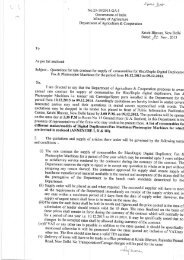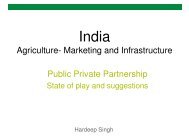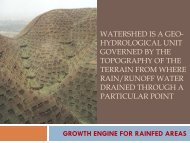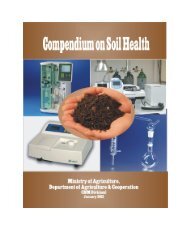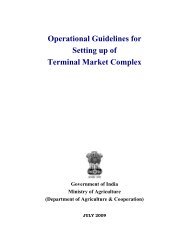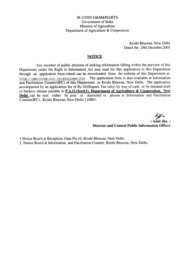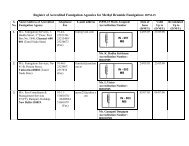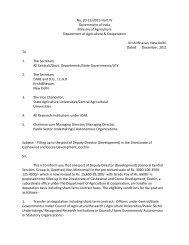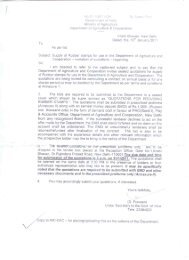Annual Report 2009-2010 - Department of Agriculture & Co-operation
Annual Report 2009-2010 - Department of Agriculture & Co-operation
Annual Report 2009-2010 - Department of Agriculture & Co-operation
Create successful ePaper yourself
Turn your PDF publications into a flip-book with our unique Google optimized e-Paper software.
<strong>Annual</strong> <strong>Report</strong> <strong>2009</strong>-<strong>2010</strong><br />
22<br />
capabilities <strong>of</strong> in season multiple crop estimation<br />
through a combination <strong>of</strong> remote sensing,<br />
econometric, agro-meteorological and land<br />
based observations, a plan scheme entitled<br />
Forecasting Agricultural Output using Space<br />
Agro-Meteorology and Land-based Observations<br />
(FASAL) was launched in August, 2006.<br />
Outsourcing agencies involved in the project are<br />
the Space Application Centre (SAC), Ahmedabad,<br />
the Institute <strong>of</strong> Economic Growth (IEG), New<br />
Delhi, and the India Meteorological <strong>Department</strong><br />
(IMD), New Delhi. SAC, Ahmedabad and IEG,<br />
New Delhi have provided forecasts for area and<br />
production <strong>of</strong> a few selected crops for Kharif<br />
<strong>2009</strong>-10, using remote sensing and econometric<br />
parameters, respectively. The development <strong>of</strong> a<br />
methodology for other specified crops is in<br />
progress. A proposal <strong>of</strong> the India Meteorological<br />
<strong>Department</strong> (IMD) for agro-meteorological<br />
forecasts has been approved for implementation<br />
by them.<br />
3.37 To further expand the scope <strong>of</strong> Remote<br />
Sensing technology for a more accurate and<br />
detailed assessment <strong>of</strong> the crop situation in the<br />
country at the national and district level, the need<br />
for establishing adequate infrastructure within<br />
the Ministry itself was considered necessary.<br />
Accordingly, a proposal from SAC, Ahmedabad,<br />
to develop a National Centre for Crop Forecasting<br />
on a Build, Operate, and Transfer (BOT) basis is<br />
under consideration.<br />
3.38 Development and Application <strong>of</strong><br />
Extended Range Forecast System For Climate<br />
Risk Management in <strong>Agriculture</strong> (ERFS): In view<br />
<strong>of</strong> the immense importance <strong>of</strong> extended range<br />
forecasting in agriculture applications, the DES<br />
in the DAC has sponsored a project titled<br />
Development and Application <strong>of</strong> Extended Range<br />
Forecast System for Climate Risk Management<br />
in <strong>Agriculture</strong> (ERFS), in collaboration with other<br />
partner organisations. i.e., IIT Delhi, India<br />
Meteorological <strong>Department</strong> (IMD), National<br />
Centre for Medium Range Weather Forecast<br />
(NCMRWF), Space Application Centre (SAC),<br />
Ahmedabad, and the Indian <strong>Co</strong>uncil <strong>of</strong><br />
<strong>Agriculture</strong> Research (ICAR). The six partners<br />
have signed a cooperative agreement in the<br />
December 2005, to work jointly on various<br />
implementation aspects <strong>of</strong> the project.<br />
3.39 The objective <strong>of</strong> the ERFS is to generate<br />
and disseminate information on rainfall and<br />
temperature with a lead time <strong>of</strong> 25-30 days. It is<br />
expected to give sufficient time to farmers to<br />
plan their cropping activities and help policy<br />
makers to take necessary corrective measures<br />
for any contingency, which may arise. Under the<br />
ERFS, a forecast for each month at the regional<br />
and district level is the ultimate goal. The project<br />
is likely to be completed in a time frame <strong>of</strong> five<br />
to six years, and in two phases. In the first phase<br />
(<strong>of</strong> two to three years), the development <strong>of</strong> a<br />
seasonal forecast system for meteorological subdivisions<br />
and agro-climatic zones is envisaged.<br />
In the second phase,a monthly forecast is<br />
targeted. Experimental monthly rainfall forecasta<br />
for monsoon <strong>2009</strong> were generated on a<br />
meteorological sub-division scale and with<br />
respect to 13 identified districts.



